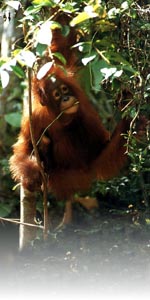MORPHOLOGY: Orang-Utan
(Pongo pygmaeus)
The average body mass for an adult male orang-utan is around 86 kilograms, and for the female it is around 38 kilograms. There is a high degree of sexual dimorphism in this species and it may be males are larger because of male-male competition for females, large males displace small males for access to females for mating (Rodman and Mitani, 1987). Pelage color ranges from reddish-orange to black. This species has a relatively short thumb. Males have flaps of fatty tissue on both sides of the face, and these develop in adulthood after the first mating. Males have throat sacs. The molars have thick enamel and low, flat cusps and have surfaces that are crenulated occlusally (Fleagle, 1988).
RANGE:
The orang-utan is found in the countries of Brunei, Indonesia, and Malaysia on the islands of Sumatra and Borneo. This species lives in tropical primary rainforests, swamp forests, and montane forests up to 2000 meters.
ECOLOGY:
The orang-utan is primarily a frugivorous species, although it also eats insects, small vertebrates, leaves, bark, and pith are also consumed. Among the most consumed fruits are: mangoes, rambutan, jackfruit, figs, and durian, which is a thick-shelled fruit that requires much strength to open. To supplement the diet for minerals, the orang-utan consumes soil. Water is obtained from tree holes by dipping the hand in and sucking up the water off of the hand. This is an arboreal and diurnal species. Each night this species constructs a nest made of branches and leaves in the trees up to 24 meters.
LOCOMOTION:
The orang-utan moves through the forest by slow quadrumanous climbing (Fleagle, 1988). Older and heavier males will come to the ground and they move quadrupedally supporting themselves with the wrists on the forelimbs, unlike Gorilla gorilla which supports their weight on the knuckles (Fleagle, 1988). Because of their large size, orang-utans must be careful when choosing supports when travelling (Rodman and Mitani, 1987), which may contribute to why they move slowly.
SOCIAL BEHAVIOR:
The basic group of the orang-utan is composed of a mother and her offspring. Males have territories which overlap one or more females and they periodically check the females especially during breeding season. This species has a polygynous mating system. Adult males exclude all other adult males from their ranges. Males spend most of their time travelling solitarily. Subadult males which have not found a territory will travel and forage with adult females an will sometimes forcibly mate with them (Fleagle, 1988). Males disperse from their natal ranges and females disperse too, but will often settle in an area near her mother's range (Rodman and Mitani, 1987).
VOCAL COMMUNICATION:
loud call: This call is given by the adult male and consists of roars at first and then rises to bellows and is enhanced by the throat sac. This is used to demarcate territories and to attract a mate, and is important because the orang-utan lives in such dense forests that it is difficult to see other individuals.
OLFACTORY COMMUNICATION:
VISUAL COMMUNICATION:
TACTILE COMMUNICATION:
social grooming: This is where one individual removes dead skin and parasites from another. This serves to maintain social bonds. In the orang-utan this occurs between the mother and her offspring.
REPRODUCTION:
The orang-utan gives birth to a single offspring about every five years.
presenting: This is where the female orang-utan hangs from a branch above the male and shows her perineum to the male. She does this to solicit a mating from the male (Hrdy and Whitten, 1987).
REFERENCES:
Burton, F. 1995. The Multimedia Guide to the Non-human Primates. Prentice- Hall Canada Inc.
Fleagle, J. G. 1988. Primate Adaptation and Evolution. Academic Press.
Hrdy, S.B. and Whitten, P.L. 1987. Patterning of Sexual Activity. In Primate Societies. eds. B.B. Smuts, D.L. Cheney, R.M. Seyfarth, R.W. Wrangham, and T.T. Struhsaker. University of Chicago Press.
Rodman, P.S. and Mitani, J.C. 1987. Orangutans: Sexual Dimorphism in a Solitary Species. In Primate Societies. eds. B.B. Smuts, D.L. Cheney, R.M. Seyfarth, R.W. Wrangham, and T.T. Struhsaker. University of Chicago Press.
nextHOME
HedWeb
HerbWeb
Primate Species
Animal Rights FAQ
Planet of the Apes
Orangutan Hotlinks
Orang Utan Culture
Paradise-Engineering
Primate Info Net Wisconsin
New Orang Utan Population
dave@bltc.com
